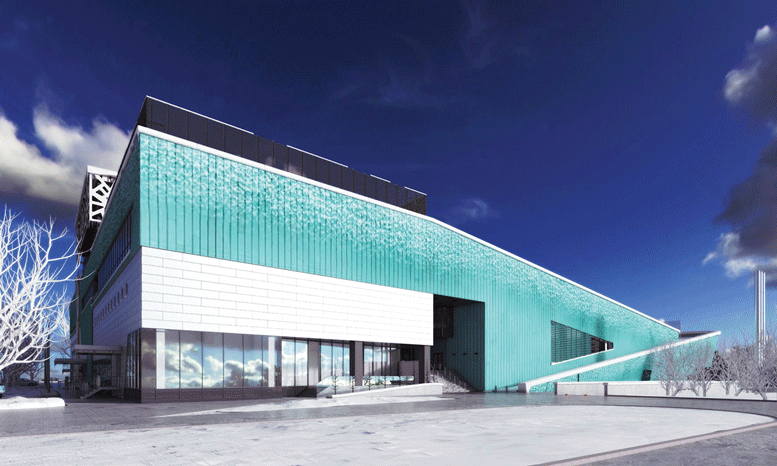Romania’s old Mihai Flamaropol Rink is being demolished, which will allow a more modern Olympic-class skating rink to rise. The project is slated for completion in two years, with an estimated cost of approximately $31m. The skating rink is in the National Sports Complex in eastern Bucharest, near the National Arena, with Louis Berger acting as the client’s project consultant.
The venture is being managed by Romania’s UTI Group and Italy’s Astaldi as a general contractor, while Arcadia Engineering was appointed general designer of the project. Arcadia, based in Bucharest with satellite offices in the UAE and Qatar, turned to BIM modelling to complete the designs for the new development. Incidentally, this is the firm’s second ice skating rink project; the first was awarded back in 2010 and went on to be used for the 2013 European Youth Olympic Winter Festival.
“The full land plot is owned by the Bucharest municipality, and inclusive of parking space, it is 26,319sqm, with a total built-up area of 19,511sqm and footprint (ground floor) of 9,573sqm. Arcadia, as general designer, is responsible for the master planning, architecture, permitting, structure, MEP, as well as International Ice Hockey Federation (IIHF) compliance in adherence with the IIHF Ice Rink Guide,” explains Florin Nistor, director general, Arcadia Engineering.
These requirements include everything from camera positioning on-site to locker room design, with extremely detailed parameters and stipulations. The scope of design work, from inception stage to detailing, is part of Arcadia’s scope for the large-scale project. The trapezoid building will be flanked on one side by easily accessible parking from the main boulevard, which allows for 119 cars plus media vehicles and team buses/shuttles.
Building and green space
The floorplan of the building includes a semi-basement, ground floor and four floors, with the fourth designed to function as a loft. From street level, the highest point of the new structure will be 25.29m high. “From the terrace of the loft, a person will be able to experience the design of the development, which includes a park and a lake with green roofing. This was done specifically to increase the greenery in the area, and allows for natural integration into the structure,” says Nistor.
All-in-all, a total of 6,489sqm of new green space will be integrated into the community once the development is completed. Nistor is keen to point out that the designs drawn up for this project were conceived with the idea of strict energy-saving and actively work to recover heat from the ice chiller system.
Roofing and lighting
The roof covering the skating rink has a span of 55.6m and is column-less. “It uses a spatial structure that hosts a walking terrace and park, which will allow attendees to enjoy the outdoor space,” comments Nistor.
In terms of lighting, building orientation and landscaping on the west side of the rink were carefully considered to maximise natural light for normal usage. Despite this, Nistor says light refraction can be kept under control during official events. The inclination of the west façade was also deemed important, as studies were executed to determine the most advantageous positioning for interior lighting purposes. Interior lighting was designed taking the requirements of modern high definition (HD) broadcasting equipment into consideration, with the entire lighting system designed to account for potential light refraction coming off the ice. The idea, according to Nistor, was to avoid interfering with the visual systems and the technologies needed to record and broadcast content internationally.
Capacity and layout
Replacing the previous Mihai Flamaropol rink (Patinoarul Mihai Flamaropol), the new skating arena is designed to seat a total of 3,137 guests. In addition to the skating space, the facility will have a gym, a swimming pool, a basketball court, indoor climbing installations, a spa and a sauna. There are also commercial areas which can potentially be used to house F&B and retail outlets. The multifunctional sports centre and the skating rink together will hold a total of 4,552 simultaneous guests. The skating rink and grounds are intended to be a hub of sports activity for the city, as multiple professional and amateur athletic competitions are already planned to take place upon the building’s completion, in sports including ice hockey, figure skating, speed skating and curling.
MEP and smart systems
The designs are said to be strictly energy-saving in terms of recovering heat from the ice chiller. The structure, a smart building, employs a fully integrated building management system (BMS), which helps to coordinate and monitor all MEP, HVAC, ice generation and maintenance services. “The HVAC and ice generation are coupled in order to enhance efficiency and diminish energy consumption for maximum savings in both electricity and gas,” says Nistor.
The BMS also ensures an organised facility management process, as all functions are centralised at a single command centre, allowing specific controls to be activated and deactivated in real time based on requirements. This includes emergency scenarios and crisis control. “This is an important factor in professional level sporting facilities that welcome large numbers of attendees,” emphasises Nistor. The facility management system in the command centre of the operation is accessible only to technical teams, and is integrated with the overall sports village system.
Location: Eastern Bucharest, Romania
Height: 25.29m
Area: 26,319sqm
Total built-up area: 19,511sqm
Building footprint: 9,573sqm
Car parking: 119 plus media vehicles and team buses

